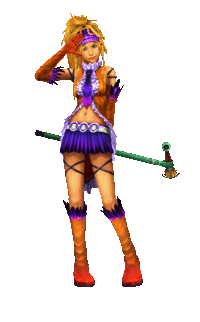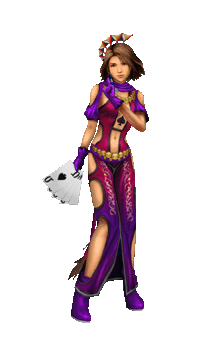

| Developer: Square Enix | Publisher: Square Enix |
| Type: RPG | MSRP: N/A | ||
| Players: 1 | Available: 11/18/03 |
|
The core of Final Fantasy X-2 bears no resemblance to Square’s previous masterpiece, aside from the graphics engine and the focus on spheres. The most obvious change in FFX-2 comes with the battle system. Ditching the timeline system that FFX employed, FFX-2 goes old school with the classic Active Time Battle system (ATB) with a couple of twists in place. For instance, many attacks in the game will actually change the length of your ATB meter. Yuna’s Trigger Happy ability will double the length of her ATB meter, while Rikku’s Steal ability will cut it in half. This forces you to manage your abilities carefully so that you’re not caught in periods of downtime against an enemy. Of course, the main draw to the game is the Dresspheres. Like in FFX, spheres are key to many things in the world of Spira. They contain movies, cook fabulous steaks, and so on. What Dresspheres do is allow the user to change their appearance and in the process, gain new abilities. For example, the Gun Mage Dressphere allows you to learn the abilities of enemies you encounter in the game, while the Gunner Dressphere equips you with a badass pistol for long-range attacks. There are also secret Dresspheres that can only be found by doing a lot of exploring, but these are usually the ones that really make the game more fulfilling. By experimenting with the various Dresspheres you acquire in the game, you can literally find one that’s perfect for every situation that you’ll face. In fact, this is emphasized right from the get go, as the first battle you face will change Yuna over from a Gunner to a Songstress, to show the advantages of changing jobs during the course of battle. All in all, the Dressphere system works a lot like the Job system in FFV, only this time you can switch jobs on the fly, provided that you have your spheres equipped on your Garment Grid. Ah, Garment Grids. These nifty items can be found around the world of Spira, and serve as the link between all of the Dresspheres that you obtain in the game. Each Garment Grid uses a different path, and bestows upon the character inherent abilities. While the “First Steps” Garment Grid offers no new abilities, “Healing Wind” gives its user the ability to cast numerous healing spells. Once in battle, you can press the L1 button to bring up the Garment Grid and switch classes. The catch here is that you can only move space at a time, but by traveling a certain path, you can activate even more spells and abilities.
Like we said earlier, FFX-2 uses the same graphics engine as the previous game, but that’s not really a bad thing, since FFX is still one of the best looking games on the system. Many graphical updates have occurred though, especially when it comes to facial expressions. This is evident in the first cutscene you’ll experience in the game, as Yuna cocks her pistol at an enemy and narrows her eyes. What’s disappointing is that many of the locales haven’t changed at all, seemingly unaffected by the two year Calm that Yuna has brought them. Even changing the camera angles for these locations would’ve made them seem new again. Aside from that, FFX-2 is shaping up to be yet another winner for Square Enix. The old ATB system gets a couple of new revisions to make it worthwhile again, and the Dressphere concept fits perfectly into the game. Still, the game’s lighthearted storyline and campy nature may turn off many people. It’s definitely one of those games that people will either love or hate. |
 So, you were bummed out by the fact that you didn’t get to see nearly enough of FFX babes Yuna and Rikku, right? If so, you probably know a hell of a lot more about this game than I do, but if not, then step back and relax. Tradition had it that no Final Fantasy game ever had a sequel. Ever. That all changed with the resounding success of Final Fantasy X two years ago. Seeing that there was quite the story to tell here, Square broke their long standing custom and announced a sequel to FFX, entitled Final Fantasy X-2. Set about two years after the events of FFX, X-2 follows the story of heroine Yuna as she teams up with her cousin Rikku and newcomer Paine to form part of the Gullwings, a group of misfits that seek to snatch up every remaining sphere in Spira. Of course, like all great stories, this one starts off because of a boy. Tidus, to be exact. While searching for spheres, Yuna stumbles across a sphere containing the image of Tidus. Determined to find out the truth about her long lost love, Yuna and the rest of the Gullwings leap into action.
So, you were bummed out by the fact that you didn’t get to see nearly enough of FFX babes Yuna and Rikku, right? If so, you probably know a hell of a lot more about this game than I do, but if not, then step back and relax. Tradition had it that no Final Fantasy game ever had a sequel. Ever. That all changed with the resounding success of Final Fantasy X two years ago. Seeing that there was quite the story to tell here, Square broke their long standing custom and announced a sequel to FFX, entitled Final Fantasy X-2. Set about two years after the events of FFX, X-2 follows the story of heroine Yuna as she teams up with her cousin Rikku and newcomer Paine to form part of the Gullwings, a group of misfits that seek to snatch up every remaining sphere in Spira. Of course, like all great stories, this one starts off because of a boy. Tidus, to be exact. While searching for spheres, Yuna stumbles across a sphere containing the image of Tidus. Determined to find out the truth about her long lost love, Yuna and the rest of the Gullwings leap into action.
 The game definitely does not play out like one long story, much like FFX did. Instead, the game is extremely non-linear. The entire story is divided into several chapters, with each of these chapters containing missions in every part of Spira. Those missions that are necessary to progress the story are marked with a “Hotspot!” signal, so that you can enter missions knowing full well that the story will go at your pace. The non-linear approach of FFX-2 is definitely a stark contrast from the rest of the series, but then again, this title is all about change, isn’t it? This change really allows player to explore the world of Spira to their hearts content. In the first chapter we were able to check up on Wakka and Lulu on Besaid Island (who are expecting a kid any time soon), Kimhari on Mount Gagazet and even Rin over in the city of Luca. Being able to check up on everyone from the previous game is probably one of the cooler things about FFX-2. While not everyone is accounted for, it’s great to discover what people have been doing since Sin was vanquished. Even some of the simpler things have returned to the game, such as picking up the Al Bhed primers and the extensive dossiers that document every character, area and story bit in the game.
The game definitely does not play out like one long story, much like FFX did. Instead, the game is extremely non-linear. The entire story is divided into several chapters, with each of these chapters containing missions in every part of Spira. Those missions that are necessary to progress the story are marked with a “Hotspot!” signal, so that you can enter missions knowing full well that the story will go at your pace. The non-linear approach of FFX-2 is definitely a stark contrast from the rest of the series, but then again, this title is all about change, isn’t it? This change really allows player to explore the world of Spira to their hearts content. In the first chapter we were able to check up on Wakka and Lulu on Besaid Island (who are expecting a kid any time soon), Kimhari on Mount Gagazet and even Rin over in the city of Luca. Being able to check up on everyone from the previous game is probably one of the cooler things about FFX-2. While not everyone is accounted for, it’s great to discover what people have been doing since Sin was vanquished. Even some of the simpler things have returned to the game, such as picking up the Al Bhed primers and the extensive dossiers that document every character, area and story bit in the game.









